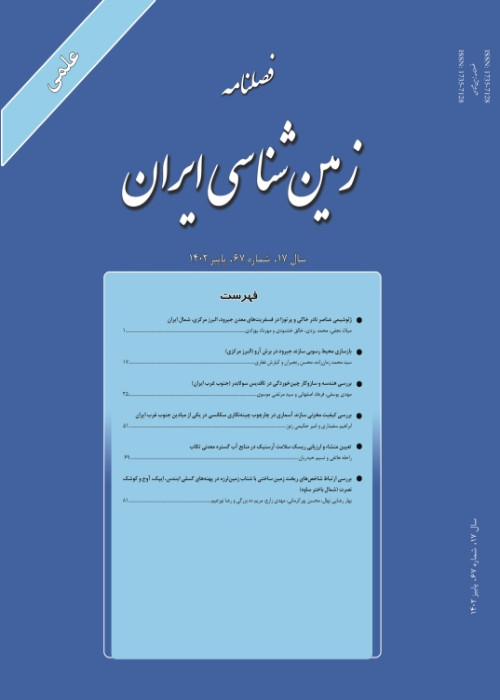The Study of alteration, mineralization, and fluid inclusion in the Howz-e-Sefid zinc-lead deposit (Central Iran)
Author(s):
Article Type:
Research/Original Article (دارای رتبه معتبر)
Abstract:
The Howz-e-sefid zinc-lead deposit is located 17 km northeast of Ardakan town in the central Iran tectonic zone. Host rock of this deposit is lower Cretaceous dolomitized carbonate rocks. In this area there are three major rock units. The Sangestan Formation as the lowest unit, is composed of shale and siltstone with calcarenitic interbeded layers. This unit is overlain by ankeritic massive dolomite and dolomitic limestone of the Taft Formation. The Abkouh Formation at the top, is composed of cherty or argillaceous limestone with massive reefal limestone. The host rock of deposit in the lower Cretaceous carbonate horizon along with other geological evidence indicate that this deposit has been primarily formed similar to the Mississipi Valley-type deposits. This conditions include carbonate and evaporatic sequences, special hydrothermal dolomitized horizons, lack of the effects of igneous intrusions and the presence of the important controling faults. Based on the observations, it can be concluded that the primary ores have been of the sulphide type including sphalerite, galena and pyrite. Due to their exposure to superficial oxidizing conditions and undergoing changes, the primary sulphide ores, have been converted into nonsulphide ore body. As a result, the primary sulphide ores have been changed into secondary minerals such as hemimorphite, smithsonite, cerusite and anglesite. In many cases, the nonsulphide minerals established in the structural fractures and fissures, shows the colloform texture. Therefore, it can be accepted that this type of minerals were formed under the effect of low temperature hydrothermal fluids.There are two types of fluid inclusions (type I: L and type II: L+V) in the carbonaceous ore bearing veins. On the basis of microthermometric study, the homogenization temperatures is between 150-260 °C. The salinity of fluid inclusions is low to intermediate (0.33-14.26 wt. % NaCl equivalent). Heating depressurization due to reduced pressure to boiling with low CO2 bearing fluid (0.62-0.98 gr/cm3) is the main mechanism of deposition. Based on evidence such as the nonhomoginity in filling degree of fluid inclusions, existence of a few vapor-rich phase shows boiling of ore fluid in faulted and fracture zones.
Keywords:
Language:
Persian
Published:
Iranian Journal of Geology, Volume:12 Issue: 47, 2018
Page:
19
magiran.com/p1914043
دانلود و مطالعه متن این مقاله با یکی از روشهای زیر امکان پذیر است:
اشتراک شخصی
با عضویت و پرداخت آنلاین حق اشتراک یکساله به مبلغ 1,390,000ريال میتوانید 70 عنوان مطلب دانلود کنید!
اشتراک سازمانی
به کتابخانه دانشگاه یا محل کار خود پیشنهاد کنید تا اشتراک سازمانی این پایگاه را برای دسترسی نامحدود همه کاربران به متن مطالب تهیه نمایند!
توجه!
- حق عضویت دریافتی صرف حمایت از نشریات عضو و نگهداری، تکمیل و توسعه مگیران میشود.
- پرداخت حق اشتراک و دانلود مقالات اجازه بازنشر آن در سایر رسانههای چاپی و دیجیتال را به کاربر نمیدهد.
In order to view content subscription is required
Personal subscription
Subscribe magiran.com for 70 € euros via PayPal and download 70 articles during a year.
Organization subscription
Please contact us to subscribe your university or library for unlimited access!



